Benefits Biochar In Composting Why You Should Use
Using Biochar In Compost
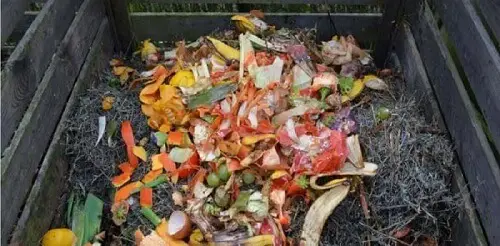
Biochar is a fine-grained charcoal. It gets created by heating biomass in an oxygen reduced environment.
To get the most benefit from using biochar in your compost bin, you want to make sure the biochar gets broken down into small pieces.
Biochar has a high surface area with the ability to absorb odors, ammonia, methane, and water. The smell from your compost can get significantly reduced by adding biochar into the mix.
Biochar/Compost blends will hold on to more nutrients, minerals, and beneficial soil microbes.
What is biochar compost?
Effect of Biochar on Compost
When biochar is added to compost, it increases microbial activity. Reduces nutrient leaching and ammonia losses from the soil. And it will significantly minimize the odor coming out from our compost.
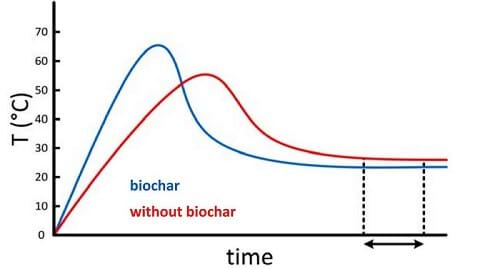
It will generally reduce the time for our compost to be ready. And minimize greenhouse gas emissions that would typically get released from our compost pile.
It will help to keep the compost moister and better aerated. It can also help to improve our plant's growth.
Biochar helps our compost to hold on to nutrients more efficiently and prevent them from draining out of our soil. The nutrient loss is reduced because the biochar binds to the nutrients holding on to them when watering the ground.
The maturity of the soil and humus content get improved by adding in biochar. Many people find that they do not have to turn over the compost as often when biochar is mixed in with it.
Compost with added biochar generally contains more beneficial microorganisms. Biochar has what is called porous space. This just means that there a solid piece of biochar is not actually sold. It is filled with many tiny space gaps internally.
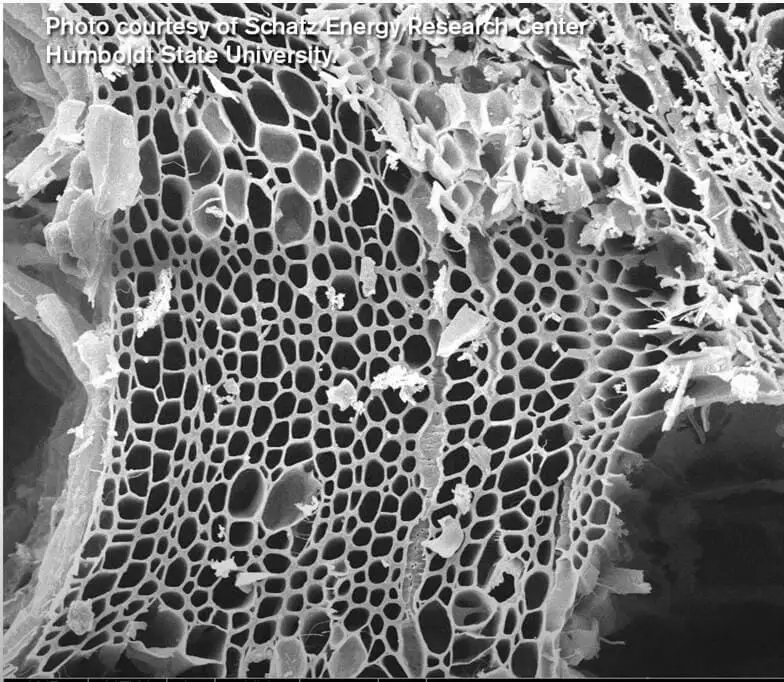
The porous space within the biochar allows the compost to have higher levels of beneficial microorganisms and fungi.
Biochar As A Composting Bulking Agent
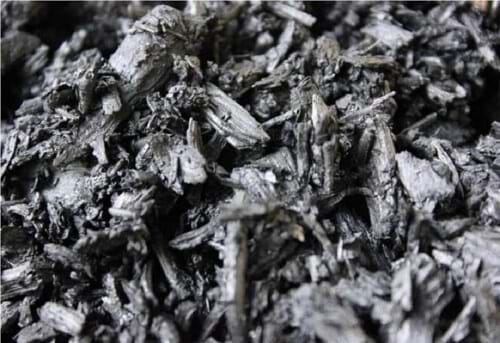
Biochar has the ideal properties to get used as a bulking agent in our composts.[3]
The bulk density and aeration of the compost are both improved with the addition of biochar.
Better aeration will allow more oxygen into the compost. The added airflow will help prevent our material from getting matted(clumped together).
It also keeps the good bacteria adequately oxygenated. Airflow is essential to keep the bacteria in the compost alive and thriving.
In the middle of our compost pile, there is significant metabolic activity happening. Better aeration will give more pathways for heat to find its way out of our compost.
Adding biochar provides more pathways to help vent out the extra heat.
Difference Between Biochar And Compost
Difference in Compost
While composting and biochar are both greenways to recycle organic waste.
Composting is a method of recycling some of our home waste. It allows us to add nutrients into our soil instead of them landing up in a landfill.
Our organic waste gets broken down by bacteria, fungi, worms, and many other microorganisms. When or organic waste gets broken down by these organisms, it adds nitrogen and carbon nutritional value back into our soil.
For composting to take place, there are four components involved.
Nitrogen (from fruits, vegetables, and grass clippings)
Carbon (from brown yard waste like leaves and wood materials. If the material is still green, it will be adding nitrogen, not carbon)
Oxygen (oxygen is needed for carbon to break down)
Water (this maintains the activity of all the microorganisms)
Example Biodegradable Items for Composting
- Fruit peels and cores
- Vegetable peels and waste parts
- Stale bread and crusts
- Coffee grounds
- Eggshells
- Pasta
- Nutshells
- Popcorn
- Shredded pieces of paper or cardboard
- Lint from the dryer
- Grass and hedge clippings
- Leaves
Items You Can Compost But Should Not
While these items can successfully get composted. It is generally recommended that we don't add them to our compost pile. Depending on where you live, these items could even be prohibited from getting added.
- Meat products
- Dairy Products
- Bones
- Grease
The problem is that these items are known to attract many different types of pests. Rats, raccoons, and neighborhood cats and dogs will all get attracted to these items.
It is also possible for diseases like E Coli to get introduced into our compost pile by using these products. This can turn our compost piles into a potential source of severe illness.
If you are in an area that allows you to compost these items. Make sure that you are only adding small amounts and turning over the pile much more frequently.
While these items are not the best for us to use in our compost piles. We can actually use them to make biochar from. Processing them into biochar will remove any dangerous bacteria and remove the smell.
We also don't have to worry about attracting pests from around the neighborhood when converting them into biochar.
Difference in Biochar
Biochar does not add nutrients to our soils like composting. It is essentially an inert material. But it will help to absorb and hold onto the nutrients created in our compost. This helps to prevent them from getting flushed away when water is applied.
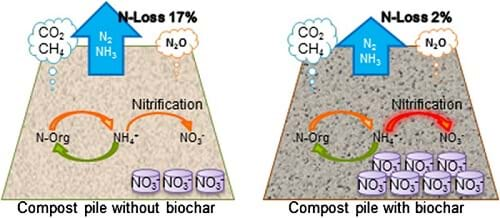
When biochar is absorbing the nutrients, it is referred to as activating or charging. You want your biochar activated before adding it into a garden. If not, it will take nutrients away from the plants in your garden.
Under the right conditions, it should only take a few weeks for the biochar to get activated when in a compost pile.
Because of the structure of biochar, it is a great bulking agent in compost. It helps to aerate the mixture. This allows for better oxygen exchange. The increased oxygen helps to increase the speed of the composting process.
Biochar will also increase water retention in the compost pile. Creating moist conditions will give our organisms in the compost pile the proper conditions for growth.
If your biochar is in large pieces, it's essential to smash it up as finely as possible. Large portions of biochar do not adequately aerate the soil. But when it is in fine pieces (1 to 5 mm in size), it provides optimal conditions within our compost pile.
Example Items for Use In Biochar
- manures
- bones
- woody plants
- grass
- animal processing leftovers
- and any other organic items
While there are many different items we can use to make biochar. It is most common to take agricultural waste for conversion into biochar.
Many farms take poultry manure compost and will convert it into biochar for use on the farms.
What Is The Ratio of Biochar to Compost
Biochar Compost Ratio
There is a wide range of biochar that we can use to add to our compost. People begin to see improvements when adding as little as 2 percent.
Most people add between 10 and 20 percent, but reports show that you can add as much as 50 percent.
50 percent seems to be the maximum you would ever use, though. Once you go beyond this amount, it can harm the microbes and be detrimental to worm lifeforms.
If you have an issue with the smell coming from the compost. Adding more biochar is a great way to have it stink less.
The more biochar we add into our compost piles, the better the airflow. The time it takes for our compost to be ready can will also get significantly reduced.
Summary
If you are making compost, biochar is a helpful amendment to begin adding into the mix.
It will speed up the process for your compost to be ready to get used. Help the microorganisms to thrive while providing better aeration and reduce nutrient leaching.
It also reduces the odor and greenhouse gas emissions that are coming out from our compost.
And best of all, it is an additional greenway for us to recycle more of our homemade waste.
Similar Articles
Biochar Fertilizer
Green Manure For Clay Soil
Difference Between Humus and Compost
What You Should Know About Mushroom Compost
[1]https://char-grow.com/composting-with-biochar
[2]https://www.sciencedirect.com/science/article/abs/pii/S0960852409012243
[3]https://www.tandfonline.com/doi/abs/10.4155/cmt.11.15
[4]https://www.tandfonline.com/doi/full/10.1080/03650340.2019.1610168?src=recsys
[5]https://biocharlie.com/blogs/news/116323909-composting-at-home-with-biochar
[6]https://wegotleaves.wordpress.com/2013/08/14/maintaining-airflow-in-compost/
[7]https://www.biochar-international.org/wp-content/uploads/2018/04/Compost_biochar_IBI_final.pdf
[8]https://bioresources.cnr.ncsu.edu/resources/the-influence-of-biochar-addition-on-chicken-manure-composting-and-associated-methane-and-carbon-dioxide-emissions/
[9]https://www.sciencedirect.com/science/article/abs/pii/S0956053X15302646
[10]https://www.gardeningknowhow.com/composting/ingredients/composting-meat-scraps.htm